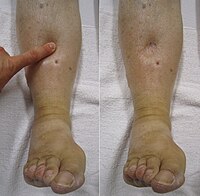
Photo from wikipedia
Stiffness plays an important role in diagnosing renal fibrosis. However, kidney stiffness is altered by perfusion changes in many kidney diseases. Therefore, the aim of the current study is to… Click to show full abstract
Stiffness plays an important role in diagnosing renal fibrosis. However, kidney stiffness is altered by perfusion changes in many kidney diseases. Therefore, the aim of the current study is to determine the correlation of kidney stiffness with water intake. We hypothesize that kidney stiffness will increase with 1 L of water intake due to increased water perfusion to the kidneys. Additionally, stiffness of the kidneys will correlate with apparent diffusion coefficient (ADC) and fractional anisotropy (FA) values before and after water intake. A 3 T MRI scanner was used to perform magnetic resonance elastography and diffusion tensor imaging of the kidneys on 24 healthy subjects (age range: 22‐66 years) before and after water intake of 1 L. A 3D T1‐weighted bladder scan was also performed to measure bladder volume before and after water intake. A paired t‐test was performed to evaluate the effect of water intake on the stiffness of kidneys, in addition to bladder volume. A Spearman correlation test was performed to determine the association between stiffness, bladder volume, ADC and FA values of both kidneys before and after water intake. The results show a significant increase in stiffness in different regions of the kidney (ie, percentage increase ranged from 3.6% to 7.5%) and bladder volume after water intake (all P < 0.05). A moderate significant negative correlation was observed between change in kidney stiffness and bladder volume (concordance correlation coefficient = ‐0.468, P < 0.05). No significant correlation was observed between stiffness and ADC or FA values before and after water intake in both kidneys (P > 0.05). Water intake caused a significant increase in the stiffness of the kidneys. The negative correlation between the change in kidney stiffness and bladder volume, before and after water intake, indicates higher perfusion pressure in the kidneys, leading to increased stiffness.
Journal Title: NMR in Biomedicine
Year Published: 2019
Link to full text (if available)
Share on Social Media: Sign Up to like & get
recommendations!